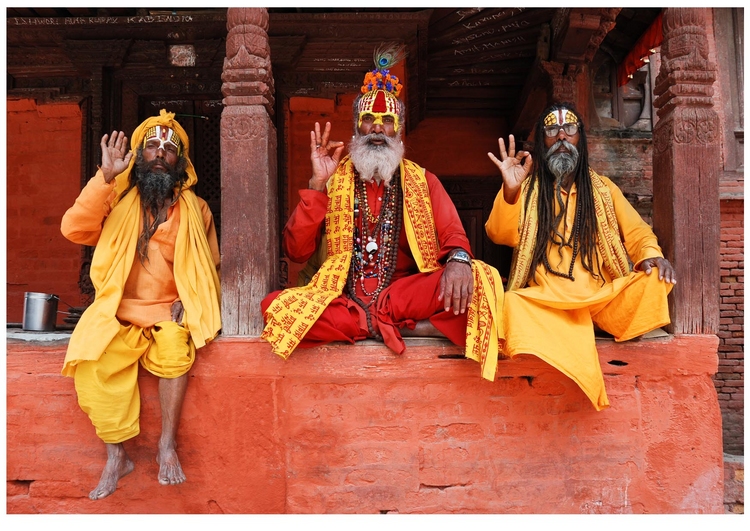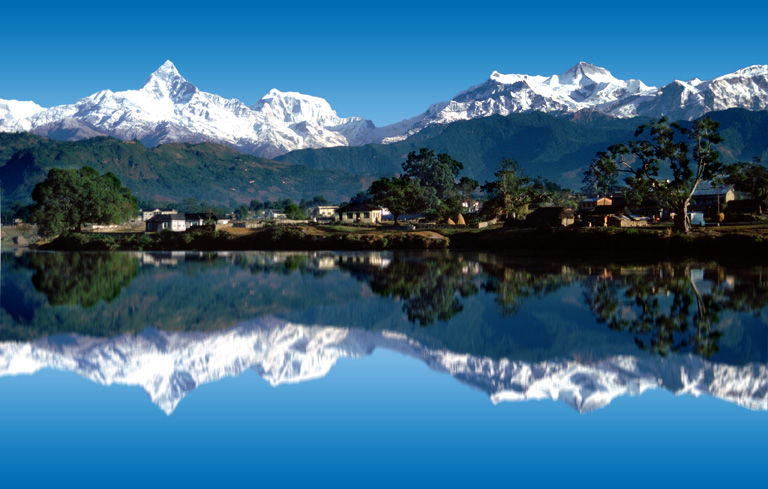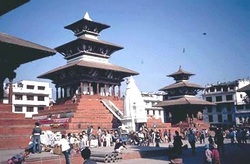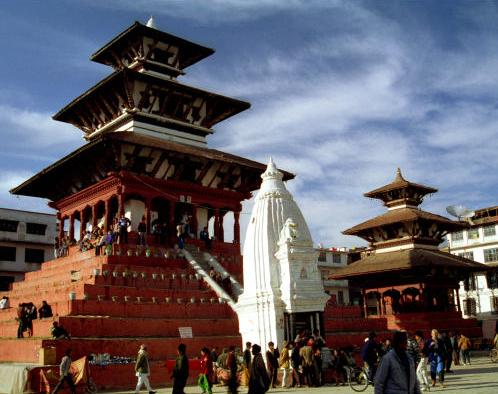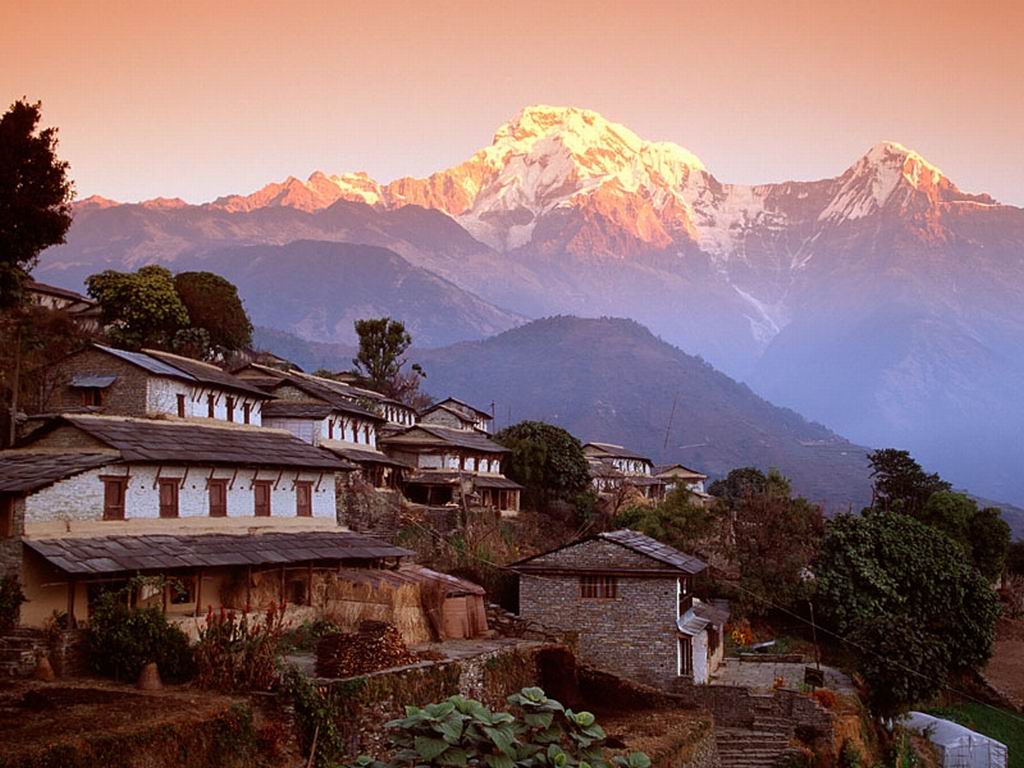People Nepal is composed of many different races and tribes. The population in Nepal has gone up to 26 million living in its many regions and speaking different dialects, following diverse social customs and lifestyles. Two of the major groups in Nepal are Tibeto-Burmans, otherwise called Mongoloids, and Indo-Aryans who are living in the southern part of Nepal.
Many of the traditions and customs were adapted according to influences and topography. A history of migration has made Nepal a melting pot of races and cultures. People in Nepal have managed to preserve their cultures, customs and traditions longer than most countries. |
Nepal is home to the most famous and tallest mountain in the world — Mount Everest. Six of the other highest mountain peaks are also found here. Nepal is rich in bio-diversity, because of its unique geography and altitude, although it is one of the least developed countries and lines up on the list of economically poor countries. In fact, one third of its population lives below the poverty line. Today, however, Nepal is slowly making its way to a better economy.
Nepal takes pride in the beautiful landscapes that it was endowed with. It has some of the most interesting buildings and places. Just like many other countries, it has its own unique culture and history. Nepal has been proud of its mysterious mountains and their vista of beauty and color. The mountains that are peaked with snow show peace and calmness, an idyllic sight to behold. The adventures that await people in Nepal are priceless and definitely unforgettable. |
Geography
Landlocked between China and India, Nepal has been known as “a yam caught between two rocks.” Known for its mountains, Nepal is generally hilly and mountainous. The shape of Nepal is roughly rectangular, and it covers 147,181 square kilometers of land. Although sandwiched between two big countries, it is purely independent from India or China.
Nepal is a small country divided into 3 physiological areas—the Hill Region, the Mountain Region and the Tarai Region. These 3 regions are divided by the government into development areas. The livelihood of the people of Nepal is inseparable from the environment that they have.
Nepal is a small country divided into 3 physiological areas—the Hill Region, the Mountain Region and the Tarai Region. These 3 regions are divided by the government into development areas. The livelihood of the people of Nepal is inseparable from the environment that they have.
HistoryNepal emerged as a nation back in the 18th century. Much of this country’s history is only known as legend. Migrations were recorded in the surrounding areas of Nepal, which gave way to the establishment of several small tribes. During the seventh century, the newer tribes took over Nepal, which was then comprised solely of the Kathmandu Valley.
|
Famous Attraction
Aside from Mount Everest, Nepal offers a variety of tourist spots that awe visitors with their beauty. It has wonderful heritage sites that attract tourists from all over the world. Traveling to Nepal gives people the chance to see fantastic lakes and forests where people can spend the night camping or spending quality time with family or friends. Some famous attractions include:
1. Royal Chitwan National Park— covering a land area of 932 square kilometers, this national park is home to many animal species that captivate visitors’ hearts. Four hundred fifty species of birds, 45 species of amphibians and reptiles and 43 species of mammals are preserved and taken care of in this wildlife haven. Guided jungle drives are available to ensure the safety of tourists and visitors.
2. Nagarkot— to have a beautiful view of the Himalayan mountain range, the lookout tower in Nagarkot offers a 360-degree view of the entire place. This is an ideal place to have the perfect view of the sunrise or sunset in Nepal. Nagarkot is located east of Kathmandu, about 32 kilometers away.
3. Pashupatinath Temple— this is one of the most sacred places for the Hindu people. People of Hinduism believe that when a person is cremated in this place and has his ashes scattered in the Bagmati River, he will be saved from all sins and will be reincarnated. Visiting this sacred place gives tourists a peek of the Hindu life.
4. Pokhara— this is the perfect spot for rafting and trekking. Located 200 kilometers to the west of Kathmandu, this is a great place for gripping and fun adventure. People also go there to have a peaceful look at the Himalayan Mountain Range or to row in Phewa Lake.
1. Royal Chitwan National Park— covering a land area of 932 square kilometers, this national park is home to many animal species that captivate visitors’ hearts. Four hundred fifty species of birds, 45 species of amphibians and reptiles and 43 species of mammals are preserved and taken care of in this wildlife haven. Guided jungle drives are available to ensure the safety of tourists and visitors.
2. Nagarkot— to have a beautiful view of the Himalayan mountain range, the lookout tower in Nagarkot offers a 360-degree view of the entire place. This is an ideal place to have the perfect view of the sunrise or sunset in Nepal. Nagarkot is located east of Kathmandu, about 32 kilometers away.
3. Pashupatinath Temple— this is one of the most sacred places for the Hindu people. People of Hinduism believe that when a person is cremated in this place and has his ashes scattered in the Bagmati River, he will be saved from all sins and will be reincarnated. Visiting this sacred place gives tourists a peek of the Hindu life.
4. Pokhara— this is the perfect spot for rafting and trekking. Located 200 kilometers to the west of Kathmandu, this is a great place for gripping and fun adventure. People also go there to have a peaceful look at the Himalayan Mountain Range or to row in Phewa Lake.
Nightlife Although people in Nepal are generally used to going to bed early, it doesn’t mean that life sleeps in Nepal during the night as well. Life is wide awake at night, with both young and older people ready to be entertained at the many places that people can choose to visit. There are many restaurants and bars that are open until after midnight, although it is a law in Kathmandu to have all music turned off by 10 pm. However, people can still opt to visit casinos or discotheques.
|
Culture
Nepal has one of the richest cultures in the world. Its culture serves as the people’s way of life in the entire society. The food, clothing, and livelihood are based on their well-preserved culture. Nepalese culture is composed of a variety of languages, dresses, manners, rituals and norms. The people have been used to keeping pace with the changing times at the same time preserving the traditions that have been followed since the earlier times. The culture of Nepal is a mixture of religion, architecture, language and beliefs.
Cuisine Nepal’s dishes are as diverse as its country. Generally, Nepal cuisines are very easy to cook and great to eat. They are particular about the nutrition and health benefits of the food. Their dishes are considered somewhat basic, but the techniques of cooking that they have acquired from the early times contribute to the tempting taste of many of their dishes. They make much use of spices such as coriander, garlic, ginger, pepper, cilantro, chilies, ghee and yak butter, during occasional times.
In most parts of Nepal, the staple food is Dal Bhat, or pulses and rice, which is eaten two times every day. Snacks, which are eaten usually during the afternoon include roti or flat bread, chura or beaten rice, vegetable curries and milked tea. These are eaten between two major meals. |
Qunar

